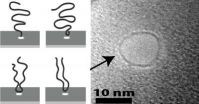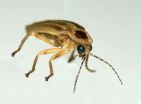(Press-News.org) New York, NY — A new study led by Columbia University Medical Center (CUMC) researchers has found that leptin, a hormone that plays a key role in energy metabolism, fertility, and bone mass, also regulates airway diameter. The findings could explain why obese people are prone to asthma and suggest that body weight–associated asthma may be relieved with medications that inhibit signaling through the parasympathetic nervous system, which mediates leptin function. The study, conducted in mice, was published in the online edition of the journal Cell Metabolism.
"Our study started with the clinical observation that both obesity and anorexia can lead to asthma," said Gerard Karsenty MD, PhD, professor and chair of genetics and development and professor of medicine at CUMC, and lead author of the study. "This led us to suspect that there must be a signal coming from fat cells that somehow affects the lungs —directly or indirectly." The most likely candidate was leptin, a protein made by fat cells that circulates in the bloodstream and travels to the brain.
Extensive evidence shows that obesity can cause narrowing of the airways (bronchoconstriction). When obesity develops in people with asthma, it exacerbates the breathing disorder and hampers its treatment through mechanisms that are poorly understood. The current study was designed to elucidate the genetic and molecular bases of the relationships among obesity, airway diameter, and lung function.
Through mouse studies, the researchers showed that abnormally low or high body weight and fat mass results in bronchoconstriction and diminished lung function. Next, they showed that leptin increases airway diameter independently of, and at a lower threshold than, its regulation of appetite.
Leptin affects the airways by decreasing the activity of the parasympathetic nervous system, a branch of the autonomic nervous system not usually associated with leptin. The researchers also showed that regulation of airway diameter occurs regardless of local inflammation in the bronchi.
The researchers conducted two subsequent experiments to determine if these findings might have bearing on asthma therapy. In one, they took obese, asthmatic mice and administered a substance that increases lung inflammation. When they infused leptin in the brain of these mice for four days, "There was no effect on inflammation, but airway diameter and lung functions were normal," said Dr. Karsenty. "This showed that, at least in the mouse, you can cure obesity-related asthma without affecting inflammation." In the second experiment, the researchers treated obese, asthmatic mice with drugs that decrease parasympathetic tone, or rate of neuronal firing. Again, the asthma abated after several days.
"The therapeutic implication is that it may be possible to correct asthma in obese people with drugs that inhibit parasympathetic signaling—and thereby increase leptin-related brain signaling," said Dr. Karsenty. Such drugs are already available. One is methacholine (Provocholine®, manufactured by Methapharm Inc.), which is used primarily to diagnose bronchial hyperreactivity, the hallmark of asthma. Clinical trials are needed before this or a more active and selective drug can be recommended for the treatment of body weight–associated asthma, Dr. Karsenty added.
The title of the paper is "Inhibition of leptin regulation parasympathetic signaling as a cause of extreme body weight associated asthma." The other contributors are Emilio Arteaga-Solis, Tiffany Zee, Charles W. Emala (CUMC); and Charles Vinson, and Jürgen Wess (NIH).
###
The study was supported by the John M. Driscoll, Jr., MD, Children's Fund Scholars, the Irving Institute/Clinical Trials Office Pilot Award, and the National Institutes of Health (RO1 DK58883).
The authors declare no financial or other conflicts of interest.
Columbia University Medical Center provides international leadership in basic, pre-clinical, and clinical research; medical and health sciences education; and patient care. The medical center trains future leaders and includes the dedicated work of many physicians, scientists, public health professionals, dentists, and nurses at the College of Physicians and Surgeons, the Mailman School of Public Health, the College of Dental Medicine, the School of Nursing, the biomedical departments of the Graduate School of Arts and Sciences, and allied research centers and institutions. Established in 1767, Columbia's College of Physicians and Surgeons was the first institution in the country to grant the MD degree and is among the most selective medical schools in the country. Columbia University Medical Center is home to the largest medical research enterprise in New York City and State and one of the largest in the United States. Its physicians treat patients at multiple locations throughout the tri-state area, including the NewYork-Presbyterian/Columbia campus in Washington Heights, the new ColumbiaDoctors Midtown location at 51 W. 51st St. in Manhattan, and the new ColumbiaDoctors Riverdale practice. For more information, visit www.cumc.columbia.edu or columbiadoctors.org.
END
Clinical pharmacologist Jens Titze, M.D., knew he had a one-of-a-kind scientific opportunity: the Russians were going to simulate a flight to Mars, and he was invited to study the participating cosmonauts.
Titze, now an associate professor of Medicine at Vanderbilt University, wanted to explore long-term sodium balance in humans. He didn't believe the textbook view – that the salt we eat is rapidly excreted in urine to maintain relatively constant body sodium levels. The "Mars500" simulation gave him the chance to keep salt intake constant and monitor urine sodium levels ...
Researchers have found new evidence that metabolic stress can increase the onset of atrial arrhythmias, such as atrial fibrillation (AF), a common heart condition that causes an irregular and often abnormally fast heart rate. The findings may pave the way for the development of new therapies for the condition which can be expected to affect almost one in four of the UK population at some point in their lifetime.
The British Heart Foundation (BHF) study, led by University of Bristol scientists and published in Circulation: Arrhythmia and Electrophysiology, found that metabolic ...
PROVIDENCE, R.I. [Brown University] — If you want to understand a novel, it helps to start from the beginning rather than trying to pick up the plot from somewhere in the middle. The same goes for analyzing a strand of DNA. The best way to make sense of it is to look at it head to tail.
Luckily, according to a new study by physicists at Brown University, DNA molecules have a convenient tendency to cooperate.
The research, published in the journal Physical Review Letters, looks at the dynamics of how DNA molecules are captured by solid-state nanopores, tiny holes that ...
The nighttime twinkling of fireflies has inspired scientists to modify a light-emitting diode (LED) so it is more than one and a half times as efficient as the original. Researchers from Belgium, France, and Canada studied the internal structure of firefly lanterns, the organs on the bioluminescent insects' abdomens that flash to attract mates. The scientists identified an unexpected pattern of jagged scales that enhanced the lanterns' glow, and applied that knowledge to LED design to create an LED overlayer that mimicked the natural structure. The overlayer, which increased ...
For over 100 years, it was assumed that the penicillin-producing mould fungus Penicillium chrysogenum only reproduced asexually through spores. An international research team led by Prof. Dr. Ulrich Kück and Julia Böhm from the Chair of General and Molecular Botany at the Ruhr-Universität has now shown for the first time that the fungus also has a sexual cycle, i.e. two "genders". Through sexual reproduction of P. chrysogenum, the researchers generated fungal strains with new biotechnologically relevant properties - such as high penicillin production without the contaminating ...
Athens, Ga. – On the list of undesirable medical conditions, a parasitic worm infection surely ranks fairly high. Although modern pharmaceuticals have made them less of a threat in some areas, these organisms are still a major cause of disease and disability throughout much of the developing world.
But parasites are not all bad, according to new research by a team of scientists now at the University of Georgia, the Harvard School of Public Health, the Université François Rabelais in Tours, France, and the Central South University, Changsha, Hunan, China.
A study ...
The research carried out at IIASA in collaboration with the Potsdam Institute for Climate Impact Research demonstrates that there is fundamental rigidity, known as lock-in, within the energy economy that favors the use of fossil fuels and nuclear power despite their large environmental and social costs. The researchers identify that this rigidity of the existing energy economy could be considerably reduced by introducing new rules that hold shareholders of companies liable for the damages caused by the companies they own. Allocating the liability between the company and ...
The flick of an antenna may be how a male wasp lays claim to his harem, according to new research at Simon Fraser University.
A team of biologists, led by former PhD graduate student Kelly Ablard, found that when a male targeted a female, he would approach from her from the left side, and once in range, uses the tip of his antenna to tap her antenna.
Ablard suggests the act transfers a yet unidentified specimen-specific pheromone onto the female's antenna that marks the female as "out of bounds," or "tagged."
The tagging-pheromone helps a male relocate the females ...
Graphene oxide has a remarkable ability to quickly remove radioactive material from contaminated water, researchers at Rice University and Lomonosov Moscow State University have found.
A collaborative effort by the Rice lab of chemist James Tour and the Moscow lab of chemist Stepan Kalmykov determined that microscopic, atom-thick flakes of graphene oxide bind quickly to natural and human-made radionuclides and condense them into solids. The flakes are soluble in liquids and easily produced in bulk.
The experimental results were reported in the Royal Society of Chemistry ...
What if Noah got it wrong? What if he paired a male and a female animal thinking they were the same species, and then discovered they were not the same and could not produce offspring? As researchers from the Smithsonian's Panama Amphibian Rescue and Conservation Project race to save frogs from a devastating disease by breeding them in captivity, a genetic test averts mating mix-ups.
At the El Valle Amphibian Conservation Center, project scientists breed 11 different species of highland frogs threatened by the chytrid fungus Batrachochytrium dendrobatidis, which has already ...


